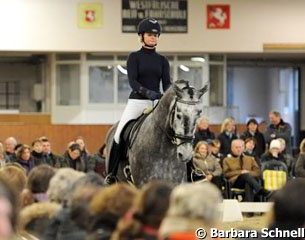
Two hundred spectators – more than twice as many as anticipated – defied the freezing temperatures right until the very last word of the Xenophon seminar held in the indoor arena of the Westphalian Riding and Driving School on Saturday 5th February 2011. And not only were they inspired by each individual contribution, but also by the way in which these complemented one another.
Susanne Miesner spoke about why the 'Principles of Riding' (Richtlinien) may be an old tradition, but are far from old-fashioned. Klaus Balkenhol demonstrated this with three different horses and three different riders, while Prof Peter Stadler, from the University of Veterinary Medicine Hanover, provided the medical basis for it all.
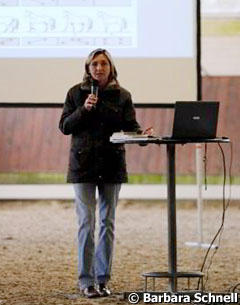 ‘What colour is Volume One?’ is the question that Susanne Miesner, in her role as examiner for apprentice Pferdewirts, has to ask repeatedly when she gets the impression that a candidate only regards the 'Principles' (Richtlinien/Guidelines) as a compulsory chore without really digesting their content. Therefore, it does not surprise her at all when this lack of fundamental theoretical knowledge is reflected the following day in the practical exam. Of course, she says, the ‘blue book’ has a long history. Of course people change, and new media are evolving at such a pace right now that they bring along new reading habits all the time. And of course horse breeding is changing as well – so fast, actually, that now we're facing the danger that the riders cannot keep up with its progress. Even more reason, according to Susanne Miesner, for the ‘tradition of riding culture’ as it is recorded in the Principles, which have always promoted the ‘horse’s welfare’ in spite of all the changes over the course of time – because despite constantly-improving breeding programmes, nothing has changed in the nature and in the basic requirements of the horse, and these needs can only be honoured, yesterday like today, when one has enough knowledge.
‘What colour is Volume One?’ is the question that Susanne Miesner, in her role as examiner for apprentice Pferdewirts, has to ask repeatedly when she gets the impression that a candidate only regards the 'Principles' (Richtlinien/Guidelines) as a compulsory chore without really digesting their content. Therefore, it does not surprise her at all when this lack of fundamental theoretical knowledge is reflected the following day in the practical exam. Of course, she says, the ‘blue book’ has a long history. Of course people change, and new media are evolving at such a pace right now that they bring along new reading habits all the time. And of course horse breeding is changing as well – so fast, actually, that now we're facing the danger that the riders cannot keep up with its progress. Even more reason, according to Susanne Miesner, for the ‘tradition of riding culture’ as it is recorded in the Principles, which have always promoted the ‘horse’s welfare’ in spite of all the changes over the course of time – because despite constantly-improving breeding programmes, nothing has changed in the nature and in the basic requirements of the horse, and these needs can only be honoured, yesterday like today, when one has enough knowledge.
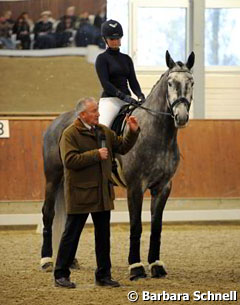 A six-year-old grey, who, true to a dam line featuring Espri, showed plenty of esprit, an extraordinarily rideable seven-year-old Farewell offspring, and finally Dablino, whose impressive transformation from a difficult problem horse to an increasingly confident champion would never have been possible without patience – with these three horses together with two of his students and his daughter Anabel, Klaus Balkenhol offered insights into his training methods. ‘Whenever there are issues with young horses, we have first got to search for a cause rather than forcefully using gadgets as a solution. Before we even begin, the equipment has got to be right: if the saddle or bridle do not fit, then the horse will inevitably become tense, and that precludes any chance of relaxation right from the start’. Klaus Balkenhol repeatedly reminded his students to use their hands as little as possible, particularly in walk. ‘We have got to let the walk unfurl rather than 'ride' it’, he said. After each schooling phase of around 10 minutes, Balkenhol recommends a short break. ‘This allows the muscles to relax and, thus, we can prevent tension’. For him, time and a realistic evaluation of the horse are essential for any work involving youngsters. He said: ‘We only start riding our horses when they are four, yet they have still learned everything when they are seven. However, we must always be aware that we cannot turn a Volkswagen into a Porsche’.
A six-year-old grey, who, true to a dam line featuring Espri, showed plenty of esprit, an extraordinarily rideable seven-year-old Farewell offspring, and finally Dablino, whose impressive transformation from a difficult problem horse to an increasingly confident champion would never have been possible without patience – with these three horses together with two of his students and his daughter Anabel, Klaus Balkenhol offered insights into his training methods. ‘Whenever there are issues with young horses, we have first got to search for a cause rather than forcefully using gadgets as a solution. Before we even begin, the equipment has got to be right: if the saddle or bridle do not fit, then the horse will inevitably become tense, and that precludes any chance of relaxation right from the start’. Klaus Balkenhol repeatedly reminded his students to use their hands as little as possible, particularly in walk. ‘We have got to let the walk unfurl rather than 'ride' it’, he said. After each schooling phase of around 10 minutes, Balkenhol recommends a short break. ‘This allows the muscles to relax and, thus, we can prevent tension’. For him, time and a realistic evaluation of the horse are essential for any work involving youngsters. He said: ‘We only start riding our horses when they are four, yet they have still learned everything when they are seven. However, we must always be aware that we cannot turn a Volkswagen into a Porsche’.
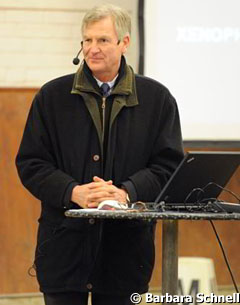 Finally, Prof Stadler made a passionate plea in support of the Training Scale from a medical perspective. The road from an anthropocentric viewpoint, which sees humans as the centre of the universe, to animal-protection laws, which allow rights to animals too, has been a long one, according to Stadler, and the concept of an animal's perception of pain is still a tricky one that will require further research. However, one thing has become certain: horses may have different behavioural patterns compared to humans when it comes to pain, but they have very similar pain receptors, and the simple fact that they cannot scream does not imply that they feel any less pain. Even after thousands of years of domestication, they are still prey animals with a highly-developed flight instinct, which forces them to hide pain as much as possible. Starting from this basis, Prof Stadler moved on to the Training Scale, which did not originate for humane reasons, but simply from convenience: that horses, as important livestock, should be kept healthy for as long as possible. Stadler used the concept of Losgelassenheit, relaxation, as an example: ‘Rhythmical movement is only right when... the horse’s muscles tense and relax without any force, truly uninhibited’, state the Principles. Since the animal’s fears and discomforts always manifest themselves in the musculature, it is only logical that true relaxation can only be reached by a horse whose management is correct and as natural as possible, and which is trained according to its nature. In other words, training problems and later health issues caused by chronic tensioning and incorrect postures become inevitable if the rider makes the mistake of not taking ‘relaxation’ seriously and does not get to the bottom of its causes.
Finally, Prof Stadler made a passionate plea in support of the Training Scale from a medical perspective. The road from an anthropocentric viewpoint, which sees humans as the centre of the universe, to animal-protection laws, which allow rights to animals too, has been a long one, according to Stadler, and the concept of an animal's perception of pain is still a tricky one that will require further research. However, one thing has become certain: horses may have different behavioural patterns compared to humans when it comes to pain, but they have very similar pain receptors, and the simple fact that they cannot scream does not imply that they feel any less pain. Even after thousands of years of domestication, they are still prey animals with a highly-developed flight instinct, which forces them to hide pain as much as possible. Starting from this basis, Prof Stadler moved on to the Training Scale, which did not originate for humane reasons, but simply from convenience: that horses, as important livestock, should be kept healthy for as long as possible. Stadler used the concept of Losgelassenheit, relaxation, as an example: ‘Rhythmical movement is only right when... the horse’s muscles tense and relax without any force, truly uninhibited’, state the Principles. Since the animal’s fears and discomforts always manifest themselves in the musculature, it is only logical that true relaxation can only be reached by a horse whose management is correct and as natural as possible, and which is trained according to its nature. In other words, training problems and later health issues caused by chronic tensioning and incorrect postures become inevitable if the rider makes the mistake of not taking ‘relaxation’ seriously and does not get to the bottom of its causes.
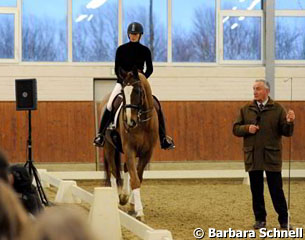 Klaus and Anabel Balkenhol demonstrated with Dablino that this seminar was not at all about arguing against the use of horses in sport. After a humorous intervention from the local comedian Else, and some concluding words from Klaus Ridder – who demanded more transparency in judging –, this was underlined by Martin Plewa, trainer and director of the School, at that evening’s ‘Hippological Dinner’: ‘We should all stand by the fact that we do sport with a horse. With the right training, this is good for the horse -- and it is the basis for its livelihood’.
Klaus and Anabel Balkenhol demonstrated with Dablino that this seminar was not at all about arguing against the use of horses in sport. After a humorous intervention from the local comedian Else, and some concluding words from Klaus Ridder – who demanded more transparency in judging –, this was underlined by Martin Plewa, trainer and director of the School, at that evening’s ‘Hippological Dinner’: ‘We should all stand by the fact that we do sport with a horse. With the right training, this is good for the horse -- and it is the basis for its livelihood’.
Photos © Barbara Schnell
Related Links
Susanne Miesner Elected Vice President Xenophon Society, Replacing Dr. Heuschmann
Xenophon Society Admonishes New FEI Steward Guidelines